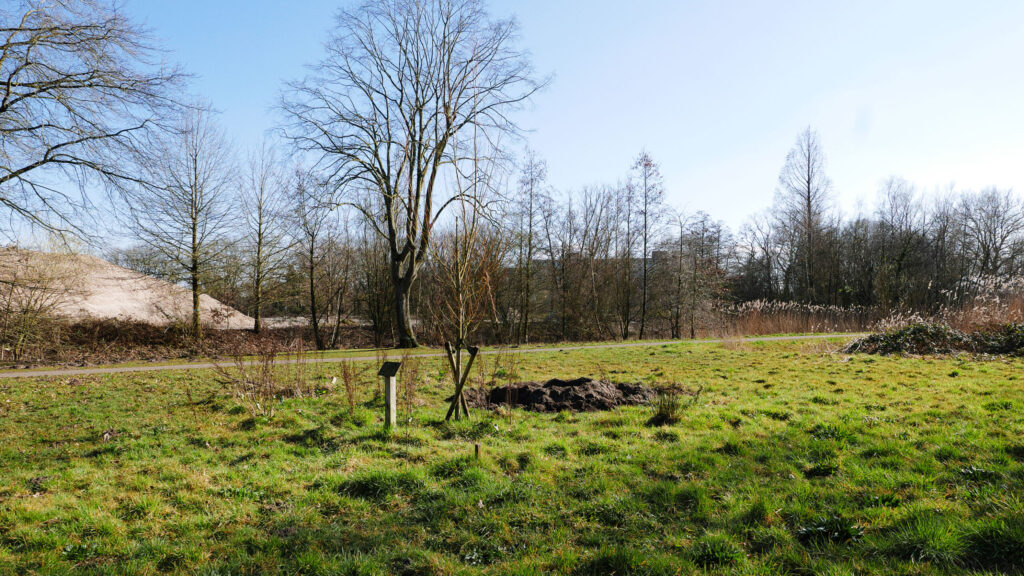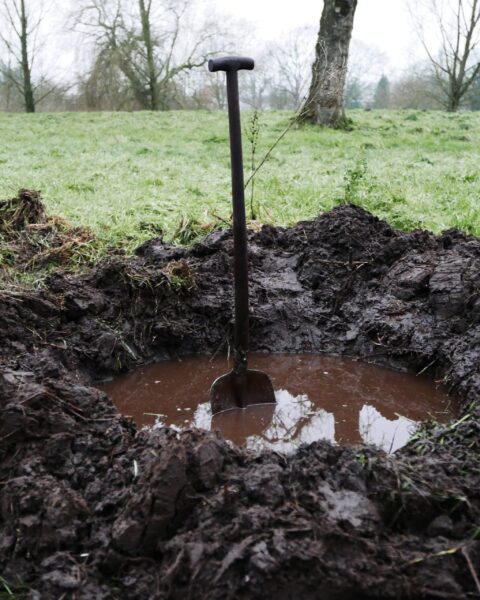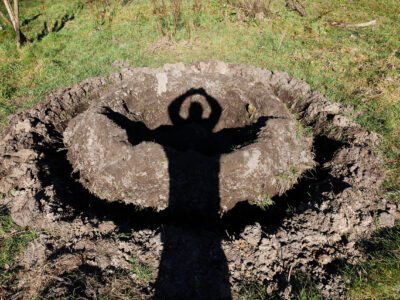8 April 2025
Article
49m2, year 9, winter 2025 | ‘At the End of a Beginning’

What is winter? It’s a question I’ve asked myself before, prompted by an invitation from Witte Rook. Winter is a time when the world—the natural world, I mean—holds its breath and waits in silence. A threshold moment where the old year has ended, yet the new year has not truly begun. The Romans only named these dark, quiet months at the very end of developing their calendar. Before that, these months were considered nothing: a nameless gap between the past autumn and the coming spring.
When I visit Roeland Rooijakkers in Zaartpark, it seems the waiting season has just come to a close. The nights are still cold, but the sun generously shines during the day. Coats are lighter now, though the shade remains a little too chilly, and the café terraces slowly turn towards the warmth like sunflowers. It’s a fitting conclusion to Roeland’s working period on the delineated 49m2. From 21 December to 21 March—the astronomical winter—this patch of ground became his canvas, and I meet him on his final day of working there.
“I came here,” he says, “to reflect on the idea of a piece of land.” That’s why he chose, of all seasons, to be active in the park during winter. After a busy stretch filled with exhibitions and productions, Roeland was looking for stillness and contemplation. Winter shifts attention back to the basics, to the earth itself—free, for a while, from the bustling life that will sprout again in spring. “In winter, there is only the earth, the water, and the sun.” And on this very day, the first shoots are beginning to rise from the concentric earthen structure he built during his time there.

Digging
Roeland works in his practice exclusively with nature. Those who visit his website will see leaves and pine needles, slate and skulls. He makes ceramics from clay that he digs up himself and harvests leaves and plants that he can use to make pigments. His preference is to use things that have already lived their lives and in that sense have already played their role: fallen leaves, stripped animal skulls, withered grass – but “played out” does not mean dead. It’s not visible in the photos he shows me, but many of his works continue to live on because of the materials he uses. The works change and discolor long after they are ‘finished’. It reflects an artist who wants to interfere as little as possible and who primarily wants to let nature and the things he discovers speak for themselves. For 49m2, he wants to take this a step further: “I want to do things without removing or adding anything.”
But if we add nothing and even remove nothing, what are we still doing?
Before the work period, Roeland had only one idea: digging. Armed with his spade, he could shape the terrain without changing it. Material that is removed in one action is also added again in the same action. I am reminded of what physicists call virtual particles. Empty space, they teach us, is never truly empty. Elementary particles and their antiparticles spontaneously appear from nothing and then, in a fraction of a fraction of a second, come together and cancel each other out without leaving a trace. Even emptiness is alive. Even winter teems. Even where nothing is added and nothing is removed, something can happen.

My little piece of nature
When I ask Roeland where his love for nature and his desire to create art without removal or addition comes from, he tells me that it has to do with a kind of purity he hopes to discover. Since I hold a master’s degree in philosophy, that word makes something stir inside me. The idea that nature could be pure or innocent, and therefore deserving of our respect and attention, is quite a banal and superficial, though not without danger, line of thought. It has more to do with people’s desire to feel good about the world than with the reality of that world itself. For me, it is hard to reconcile this with the way he uses living and changing materials—materials that are decidedly “contaminated” by mutability.
I press him further, and it soon becomes clear that Roeland has his own ideas about purity. For example, buying art materials in a store is not pure. “Things that lie in the store have had their history stripped.” It has to do with our relationship to things. If I understand Roeland correctly, he is pointing out something that Karl Marx also noticed: we are all in direct relation to our surroundings and the objects we use. These objects all hold personal value for us, a value that is not determined by the idea of their value in general. A block of clay in his studio holds direct value for Roeland because he uses it for work and, when he has dug it up himself, because it carries a meaningful history with it. In contrast, a piece of clay in a store has a value expressed in euros that is the same for every piece, for every consumer, regardless of when it is bought, and thus market relationships erase direct relationships and lived histories.
These are the kinds of questions he dealt with while digging (not Karl Marx, I mean, but questions about our direct and indirect relationships to things and nature). As he dug, nature also began to mingle in the conversation. Although his initial instinct was simply to dig as deep as possible, digging in the park enclosed by two rivers quickly ran into the high water table. “The ground pointed me to the laws of nature. It quickly became a dialogue.” What was supposed to be a deep pit became a shallow mirror: “But that was good input for reflection. You see that what is in your head doesn’t just become reality.” During the rest of the work period, the pit continued to fill and empty, the water froze and melted again, Roeland made circular sand embankments and saw them collapse due to changing conditions.
Roeland became increasingly impressed with this dialogue with the small piece of land, and, as he tells me, the real result of it is ultimately not visible in the Zaartpark. Inspired, he went in search of a piece of nature that he could maintain in the long term and from which he could harvest materials for his work. Eventually, he ended up at the “Mijn Stukje Natuur” project in Flevoland, which provides small plots of wild nature to people with the idea that they may do whatever they want with them, as long as it happens in dialogue with the existing nature. So no agriculture or non-native species, but food forests or a quiet spot to hang your hammock and read a book.
For Roeland, it became a place where he could collect material for his visual work. But where he had previously been able to take materials from the land, here he could also give back, for example by sowing native species and ensuring the right conditions for the best growth.

Simia naturae
It is said that art imitates nature. We usually say this when we stand before a still life, a landscape painting, or when the curves of a sculpture remind us of the curves of a human. But there is an even more fundamental way in which art and nature are alike: both must relate to what I will call the problem of the beginning. The problem of the beginning is that once you start something, you also need to figure out how to end it. Things that begin, begin incomplete and thus ask to be finished. Before life covered the Earth’s crust, the planet knew no seasons, only one long, indifferent winter. Not the sun, but the plants (which, of course, align with the sun) determine when the year begins and ends. The creation of artworks follows a similar process (not for nothing did Immanuel Kant in his influential book on beauty discuss flowers as much as artworks). The empty canvas of the painter is a complete object, but as soon as the brush makes the first stroke, we suddenly have to deal with a very new and incomplete object: no longer an empty canvas, but an unfinished painting. In that sense, starting something is always a step backward: something that is what it is transforms into something that is not yet what it must become.
But what if the ground is your canvas? What if the beginning of nature is the point where your work as an artist ends? Or vice versa, if the end of nature (dead leaves, skulls) is the material with which you as an artist begin? A mutual taking of what is finished and then making it incomplete again. A dialogue that sparks the seasons. Although the term “land-based art” seems appropriate, it seems to me that we are ultimately dealing with time-based art here. This is also what I find in my notes from my conversation with Roeland. At the end of the series of scribbles representing our discussion of the concept of purity, it says, underlined and circled: “purity = time” – the time that precisely changes everything and breaks everything.
In the winter of 2025, in the Zaartpark in Breda, it seems something has begun.
(Translation by Chat GPT)

